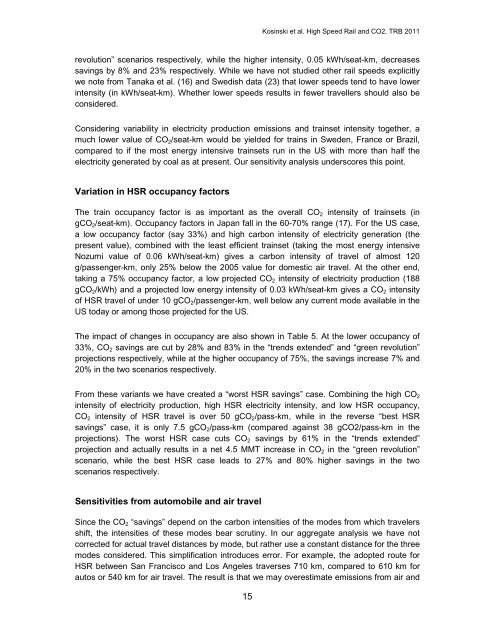Analysis of High-Speed Rail's Potential to Reduce CO2 Emissions ...
Analysis of High-Speed Rail's Potential to Reduce CO2 Emissions ...
Analysis of High-Speed Rail's Potential to Reduce CO2 Emissions ...
You also want an ePaper? Increase the reach of your titles
YUMPU automatically turns print PDFs into web optimized ePapers that Google loves.
15<br />
Kosinski et al. <strong>High</strong> <strong>Speed</strong> Rail and <strong>CO2</strong>. TRB 2011<br />
revolution” scenarios respectively, while the higher intensity, 0.05 kWh/seat-km, decreases<br />
savings by 8% and 23% respectively. While we have not studied other rail speeds explicitly<br />
we note from Tanaka et al. (16) and Swedish data (23) that lower speeds tend <strong>to</strong> have lower<br />
intensity (in kWh/seat-km). Whether lower speeds results in fewer travellers should also be<br />
considered.<br />
Considering variability in electricity production emissions and trainset intensity <strong>to</strong>gether, a<br />
much lower value <strong>of</strong> <strong>CO2</strong>/seat-km would be yielded for trains in Sweden, France or Brazil,<br />
compared <strong>to</strong> if the most energy intensive trainsets run in the US with more than half the<br />
electricity generated by coal as at present. Our sensitivity analysis underscores this point.<br />
Variation in HSR occupancy fac<strong>to</strong>rs<br />
The train occupancy fac<strong>to</strong>r is as important as the overall <strong>CO2</strong> intensity <strong>of</strong> trainsets (in<br />
g<strong>CO2</strong>/seat-km). Occupancy fac<strong>to</strong>rs in Japan fall in the 60-70% range (17). For the US case,<br />
a low occupancy fac<strong>to</strong>r (say 33%) and high carbon intensity <strong>of</strong> electricity generation (the<br />
present value), combined with the least efficient trainset (taking the most energy intensive<br />
Nozumi value <strong>of</strong> 0.06 kWh/seat-km) gives a carbon intensity <strong>of</strong> travel <strong>of</strong> almost 120<br />
g/passenger-km, only 25% below the 2005 value for domestic air travel. At the other end,<br />
taking a 75% occupancy fac<strong>to</strong>r, a low projected <strong>CO2</strong> intensity <strong>of</strong> electricity production (188<br />
g<strong>CO2</strong>/kWh) and a projected low energy intensity <strong>of</strong> 0.03 kWh/seat-km gives a <strong>CO2</strong> intensity<br />
<strong>of</strong> HSR travel <strong>of</strong> under 10 g<strong>CO2</strong>/passenger-km, well below any current mode available in the<br />
US <strong>to</strong>day or among those projected for the US.<br />
The impact <strong>of</strong> changes in occupancy are also shown in Table 5. At the lower occupancy <strong>of</strong><br />
33%, <strong>CO2</strong> savings are cut by 28% and 83% in the “trends extended” and “green revolution”<br />
projections respectively, while at the higher occupancy <strong>of</strong> 75%, the savings increase 7% and<br />
20% in the two scenarios respectively.<br />
From these variants we have created a “worst HSR savings” case. Combining the high <strong>CO2</strong><br />
intensity <strong>of</strong> electricity production, high HSR electricity intensity, and low HSR occupancy,<br />
<strong>CO2</strong> intensity <strong>of</strong> HSR travel is over 50 g<strong>CO2</strong>/pass-km, while in the reverse “best HSR<br />
savings” case, it is only 7.5 g<strong>CO2</strong>/pass-km (compared against 38 g<strong>CO2</strong>/pass-km in the<br />
projections). The worst HSR case cuts <strong>CO2</strong> savings by 61% in the “trends extended”<br />
projection and actually results in a net 4.5 MMT increase in <strong>CO2</strong> in the “green revolution”<br />
scenario, while the best HSR case leads <strong>to</strong> 27% and 80% higher savings in the two<br />
scenarios respectively.<br />
Sensitivities from au<strong>to</strong>mobile and air travel<br />
Since the <strong>CO2</strong> “savings” depend on the carbon intensities <strong>of</strong> the modes from which travelers<br />
shift, the intensities <strong>of</strong> these modes bear scrutiny. In our aggregate analysis we have not<br />
corrected for actual travel distances by mode, but rather use a constant distance for the three<br />
modes considered. This simplification introduces error. For example, the adopted route for<br />
HSR between San Francisco and Los Angeles traverses 710 km, compared <strong>to</strong> 610 km for<br />
au<strong>to</strong>s or 540 km for air travel. The result is that we may overestimate emissions from air and

















